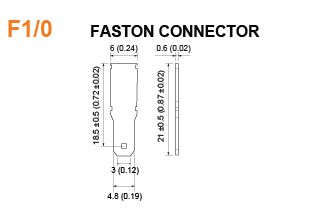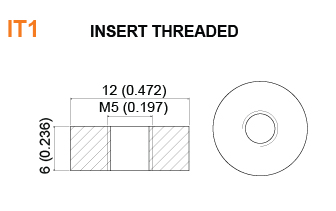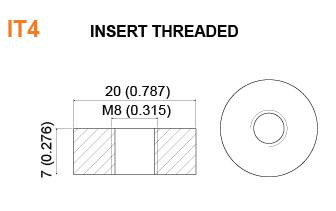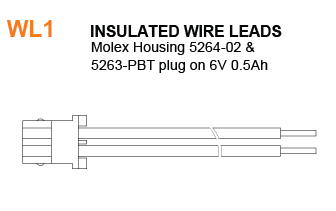Battery Buying Guide
- About SLA Batteries
- Advantages
- Battery Cells
- Calculating Watts
- Battery Shelf Life
- Battery Life Expectancy
- SLA battery types
- GEL and Absorbent Glass-Matt design
- Deep Cycle and Starting batteries
- High-Rate Discharge batteries
- Popular Applications
- UPS Units
- Telecom Equipment
- Security Alarms
- Electric Scooters and Wheelchairs
- Powersports (Motorcycles, ATVs, Snowmobiles)
- Heavy Duty
- Marine
- Medical
- Charging SLA Batteries
- General
- Charging Batteries for Standby Applications
- Discharge Cycles
- Connecting batteries
- In Series
- Parallel
- Important information before you buy
- Appendix 1: Battery Terminals
- About Ni-Cad batteries
- About Alkaline batteries
- About Emergency Ballasts
About SLA Batteries
ADVANTAGES
- Maintenance Free
- No risk of leakage
- Low self-discharge rate
BATTERY CELLS
SLA batteries have a different number of cells depending on their voltage. The nominal voltage of a lead acid battery cell is 2.00 Volts, so a 6-Volt SLA battery has 3 cells and a 12-Volt battery has 6 cells. Keep in mind that when measuring the open circuit voltage (OCV), a fully charged battery should read 2.25V/cell - a 12-volt battery should read 12.70 to 13.40 volts and a 6-volt battery - 6.25 to 6.37 volts. If a battery is not performing as expected it may have a dead cell.
CALCULATING WATTS
The power of a battery is calculated in Watts. To calculate Watts you simply multiply the Volts of the system by the amperage. The formula is P(W) = V(V) × I(A) where P is the power, V is the voltage and I is the current calculated in amperes.
Example: 1.5A * 12V = 18W
BATTERY SHELF LIFE
SLA batteries have a low self-discharge rate - about 40% per year or 3.3% per month. These batteries are able to be stored without charging for up to 5-6 months when at full capacity, but doing so is not recommended. At least every 2-3 months you should top charge them. In order to prolong their shelf life, SLA batteries should be stored and maintained properly.
Best Practices
- Store batteries in a cool, dry place (optimally 75 degrees Fahrenheit / 23 degrees Celsius or less)
- Periodical top charging of the batteries is recommended
- Store batteries in a fully charged state
BATTERY LIFE EXPECTANCY
The overall life expectancy depends on the battery's application, frequency of usage, temperature and discharge cycles. The number of discharge/charge cycles that can be reached by a battery depends on the depth of discharge and operating temperature. Lifetimes of 500-1200 cycles are most common. SLA batteries used in stand-by applications such as alarm systems tend to last longer.
SLA BATTERY TYPES
GEL AND ABSORBENT GLASS-MATT DESIGN
There are two SLA battery technologies that are most commonly known on the market - GEL and AGM. The AGM type is typically preferred for applications that require high burst of power and the GEL type is mainly used in applications requiring frequent or daily use.
AGM stands for Absorbed Glass Mat. These types of batteries use special glass matt to keep the battery electrolyte between the lead plates. This allows for less resistance within the battery, which in turn provides a higher discharge. AGM batteries are cheaper but can have more power capacity compared to the same size GEL batteries. However they are not able to cycle as many times as the GEL.
The GEL battery uses a silica type gel to suspend the electrolyte. These batteries are more expensive but have superior cycle life compared to AGM batteries. However GEL technology gives off a lower discharge than the AGM. GEL batteries perform better in slightly higher ambient temperatures. The price per cycle of the two types is comparable.
DEEP CYCLE AND STARTING BATTERIES
Deep cycle batteries are able to provide sustained power over extended periods of time and are designed to be repeatedly charged and discharged. Starting batteries, also known as SLI (starting, lighting, ignition) batteries, must be able to deliver a large amount of power over a short period of time. The main difference in their construction lies in the thickness of the lead plates inside them and the density of the active material. There are some batteries designed to handle both starting and deep cycle applications. They are known as Dual Purpose batteries.
Some of our batteries are also described as High-Rate Discharge batteries. They are of the AGM type and are constructed with lead plates, which are thin and enable a quick, as well as heavy discharge of energy, in a short period of time. They are ideal for use in UPS units.
POPULAR APPLICATIONS
UPS - Uninterruptable Power Supplies are used to provide a backup power source most commonly to computer systems and other connected devices. They also act as power "conditioners" and ensure consistent flow of electricity without drops or surges, thus offering protection against power problems such as blackouts, brownouts, power surges and power line noise. When a blackout occurs, an inverter turns on and converts battery power into a sine wave output, which is the optimum waveform for electronic equipment. When power returns, the inverter turns back off and the battery begins recharging.
UPS units come in many sizes and their runtime varies depending on the electrical load generated by the devices that they are connected to. You can determine the best UPS for your needs by a simple formula. First you need to find the voltage and amperage ratings of the devices you need to power. Next you will need to multiply the volts by the amps of each device and them sum up the results for all devices. Add additional 25% to the resulting number and compare the total to the "VA" rating of your UPS.
The run-time UPS depends on the type and size of batteries, the rate of discharge and the efficiency of the inverter. UPS backup units require batteries designed to provide a high power output over a relatively short period of time. This is why High-Rate Discharge batteries are the preferred choice when it comes up to UPS units.
Reliable telecommunication backup equipment is essential for the growing global demand for mobile services. Some SLA batteries have been designed to provide reliable performance during long discharges, which is essential for power supply systems used in data networks, wireless communication, high-speed data transmission and cable TV. The dimensions of the Telecom batteries that we carry are such that they are able to fit in standard Power Cabinets. Our batteries are also designed for long life, offer high energy density and are easy to install.
SLA batteries can be found in various alarm systems such as ADT Security, ADI / Ademco or GE Security. That's why we carry a wide selection of 6 and 12 Sealed Lead Acid batteries with different dimensions to fit your alarm system. You do not want to leave your home and loved ones unprotected even for a moment. This is why you need to replace your batteries on time!
Our batteries can be used in various types of:
- Access Control Systems
- Home Alarm Systems
- Burglar Alarm Systems
- Security Systems
Electric Scooters AND Wheelchairs
SLA batteries are very popular in electric scooters and wheelchairs. Generally deep cycle batteries tend to perform better in these applications as they are more suited to handle the everyday prolonged use. We recommend gel batteries when it comes up to mobility applications. The run time of these batteries depends on a variety of factors such as surface elevation, depth of discharge, temperature, weight of the rider and other maintenance factors.
Our batteries can be used in various types of:
- Electric scooters and bikes
- Electric wheelchairs
- Ride-on Toys
- Golf Carts
POWERSPORTS (Motorcycles, ATVs, Snowmobiles)
Powersports SLA batteries are designed for use in motorcycles, ATVs, snowmobiles and personal watercrafts. They offer extreme freeze, heat and vibration resistance. An important feature of these batteries is their elevated cranking amps. Cranking amps represent the number of amperes a battery can deliver for 30 seconds and maintain at least 1.2 volts per cell at 32 degrees F (0 degrees C). Basically they determine the amount of power you have to start your vehicle.
Some of our clients mistakenly order general-purpose SLA batteries and use them in Powersports applications. This is not advised as general purpose SLA batteries are not designed for such use and more likely to fail at starting your vehicle and to have a much shorter life.
We carry maintenance free, also known as factory activated, motorcycle batteries. They differ from Conventional Motorcycle Batteries in that they do not need constant care and addition of water, which saves you a lot of time and effort. They also will not spill acid and have a slower discharge rate than the conventional batteries.
Our Powersports batteries can be used in:
- Motorcycles
- ATVs
- Personal Water Crafts (PWC)
There are some SLA batteries, which are designed to be rugged and to perform in the toughest conditions. They need to provide massive starting power and extreme durability.
Heavy Duty Batteries are most often used in:
- RV's
- Farming equipment
- Construction equipment
- Cargo vans
- Tractor trailers
SLA batteries are often used in boats and watercrafts. Depending on what you plan to use it for you may need a Starting or a Deep Cycle marine battery. In some cases a Dual Purpose battery can be the right choice as it can be used for both starting your engine and powering the numerous onboard devices.
Various types of medical equipment use SLA batteries. Devices such as vital signs monitors, pumps and stair lifts rely on Sealed Lead Acid batteries to deliver them power.
CHARGING SLA BATTERIES
GENERAL
There are two things you need to remember when charging a battery. First, charge the battery back to the level it was at before any discharge. Second, to charge a 12-Volt battery you will need a 12 Volt charger and for a 6-Volt battery you will need a 6-Volt charger. In other words you have to make sure that the voltage of the charger matches the voltage of the battery. Keep in mind that if you connect two 12 volt batteries in series to get 24 volts, then you may use a 24 volt charger, or charge the batteries separately.
One common question regarding charging SLA batteries is for how long you have to charge them. There is a simple formula you can use to get an estimate of the needed charging time. Multiplying the amperage of the battery by 1.3 and then dividing the total by the amperage of the charger will give you the hours for which you have to charge the battery, assuming it was completely discharged.
When connected to the charger, SLA batteries reach 70% of their capacity in the first couple of hours (rapid charge stage). The remaining 30% of the charge is completed at a much lower speed during.
Battery chargers can come with different connectors or clips. Some of the most popular ones are the 3-pin XLR connector and the Alligator clip. You have most likely seen XLR connectors, as they are very popular in audio and video equipment. They come in male and female versions. Chargers use the male version. Alligator clips are named that way due to their resemblance of the jaws of an alligator. You have most likely seen a large version of these clips at the end of jumper cables.
CHARGING BATTERIES FOR STANDBY APPLICATIONS
Most SLA batteries are rarely cycled due to their application (UPS, burglar alarms, exit lights), rather they are kept in a standby mode and are constantly charging, in other words, receiving a float charge. A float charge comes at a constant float voltage of 2.25 – 2.30 Volts per cell. This low voltage prevents the battery from losing capacity and prolongs battery life expectancy. Most stand-by applications have built-in chargers responsible for providing float charge and maintaining its batteries. Keep in mind that sometimes these chargers do not work properly and can fault the battery sensor of the device to show a low battery signal. Often the battery does not need to be replaced. This is why we recommend troubleshooting the application and either check the voltage readings of the battery or the output voltage of the application’s charger.
DISCHARGE CYCLES
Discharge cycle is the process of discharging and then recharging a battery. The depth of discharge affects the number of discharge cycles. If you fully discharge your battery before you start recharging, you are performing “deep discharge”, partially discharging it is called “shallow discharge”. The less you discharge the battery, the more cycles you will get.
CONNECTING BATTERIES
IN SERIES
By connecting the batteries in series you are doubling the voltage and maintaining the same capacity (amp hours). Connect the positive terminal of the first battery to the negative terminal of the second one. From the two free terminals connect the positive to the power lead on your devise, and the negative to the ground connection of your application.


PARALLEL
By connecting the batteries in parallel you are doubling the capacity (amp hours) and maintaining the same voltage. Connect the positive terminal of the second battery to the positive terminal of the first battery. Do the same with the negative terminals. Connect your application to the positive and negative terminals of the first battery.


IMPORTANT INFORMATION BEFORE YOU BUY
In order to find the best replacement for your original battery you need to compare the physical dimensions, Volts and Amp power of your original model to what we have listed as a recommended replacement on our website. Besides physical dimensions you also need to check battery terminals (F1, F2, NB, WL, U, F1/0), which are the metal connectors on top of the battery. To determine what terminal your battery has, you will need to look at their form and determine if they have a flat connector, nut and bolt or wires, and then measure their sizes. Please see Appendix 1 for more information about battery terminals.
APPENDIX 1: BATTERY TERMINALS
Q. Are F and T terminals the same?
A. Yes, the F and T type terminals are interchangeable
Example: F1 = T1 and F2 = T2
FASTON CONNECTOR






NUT AND BOLT










INSERT THREADED








INSULATED WIRE LEADS




RECESS TERMINAL


PRESSURE CONTACTS


H-TYPE CONNECTOR


SPRING TERMINAL




NiCad batteries are a type of rechargeable batteries that use nickel oxide hydroxide and metallic cadmium as electrodes. They are mostly used in consumer electronics and are interchangeable with Alkaline batteries for most applications.
ADVANTAGES
- Fast and simple charging even after prolonged storage
- High number of charge/discharge cycles
- Good load performance
- Rugged and forgiving if abused
- Good low-temperature performance
In an alkaline battery, the negative electrode is zinc and the positive electrode manganese dioxide. They are available in a variety of sizes including AAA, AA, C, D and 9Volt sizes and are widely used in consumer electronics. They can be both rechargeable and non rechargeable.
ADVANTAGES
- Four times the capacity of a equivalent size rechargeable Nickel Cadmium
- Suitable for high drain rate applications
- Good shelf life
- Made from non toxic chemicals
Many buildings in the United States are required to provide reliable and sufficient emergency illumination. When normal power fails, emergency ballasts switch on to provide much needed illumination for at least 90 minutes. When the power comes back on the ballasts start charging. The battery is fully charged in 24 hours.
